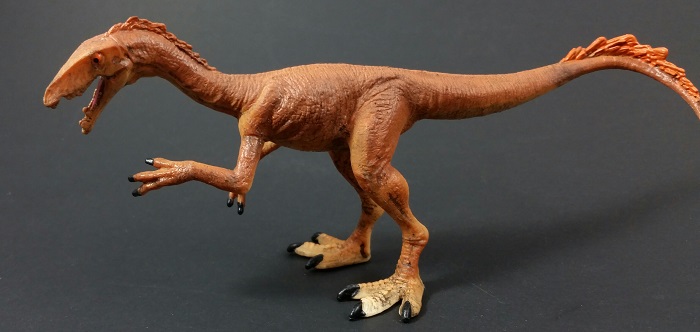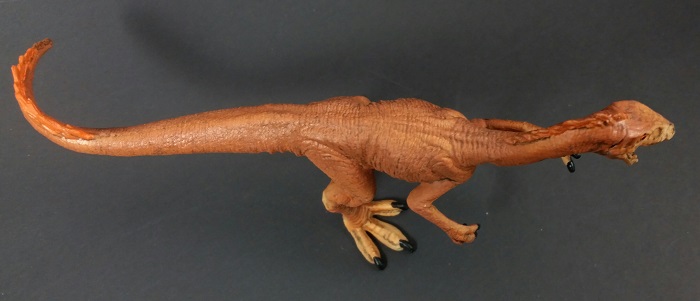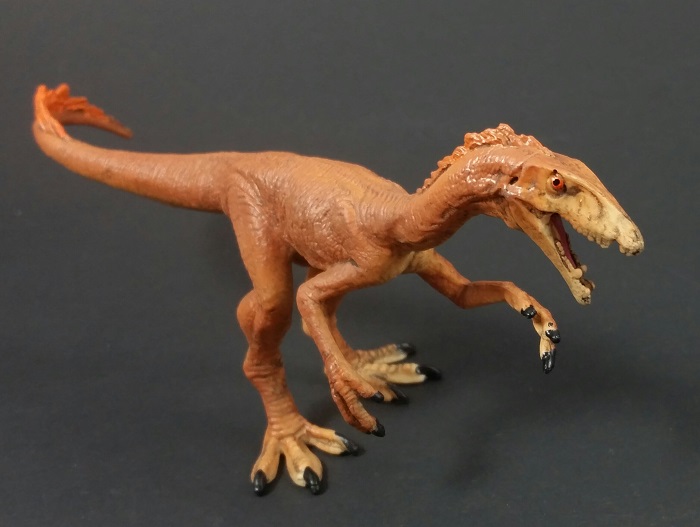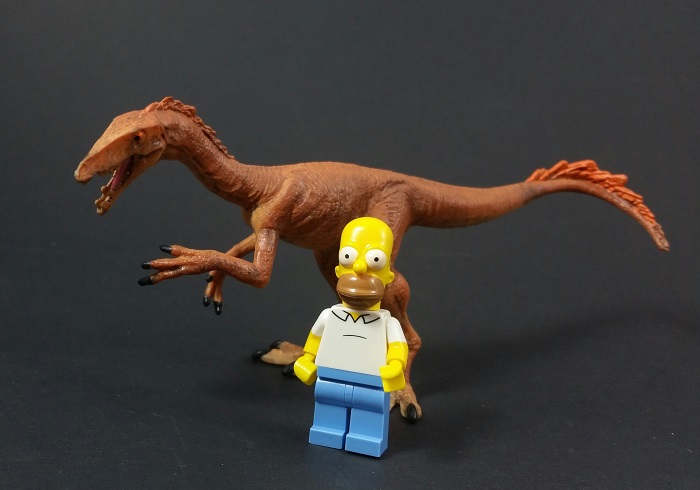The kinds of dinosaur toy fans who care about accuracy and realism tend to find Schleich frustrating, perhaps because Schleich has, at the very least, the technical capacity to make outstanding figures. For example, their recent Kentrosaurus was a solid effort, but in the same year as a good figure like that they’ll release arrestingly ugly toys. This year’s Schleich releases are a mixed bag, but one of the better ones is this Tawa hallae, a basal theropod of the Late Triassic.

Tawa was a mid-sized predator, about 2.5 meters long. It would have weighed about the same as the coyotes that now roam where its fossils were found. If this figure looks kind of like a Coelophysis to you, good eye! They’re both part of the messy thicket of phylogenetic branches around the earliest proper theropods and they share both primitive and novel features. From above, you can see that this figure has oversized feet, in the service of stability (and in fact, this toy stands very well). Some people really hate bases on theropods. Some people really hate oversized feet. Others hate having to lean a theropod with correctly-sized feet on something to keep it upright. There is no solution that makes everybody happy, so I’ve resolved to be pretty accepting of whatever solution companies use. That said, they should have the right number of toes. This one has one too few–Tawa hadn’t acquired the characteristic three-toed feet of later theropods.

This particular figure, sculpted by Vlad Konstantinov, does a good job of depicting a lithe carnivore, with some of the muscles and even a bit of bone visible through the russet-colored skin. It is, perhaps, a bit too lithe, especially around the base of the tail, where one of the major muscles responsible for moving the thigh backward is underdeveloped. The feathers are an odd touch and are reminiscent of a reconstruction by Siddhartha Ahearne. There are reasonable arguments both for and against an animal in Tawa‘s neighborhood of the dinosaur family tree having feathers, but this feather distribution seems like an implausible half-measure to me. The brighter shade of orange used to highlight them suggests a display function, which would be fine if Tawa didn’t have to worry about marauding stem-crocodiles, the largest terrestrial predators of the time. The paint job on the figure is good but not great: a dark wash makes the sculptural details pop, and the claws are painted a nice contrasting black, but the mouth and teeth are just the same pale orange as the belly, the only added detail being a streak of magenta along the tongue.

The head of this figure is just a little bit gaunt but it is recognizably the head of an early theropod. It shows the little notch in the upper jaw where the maxilla and premaxilla meet, although if it weren’t for a gap in the tooth row it would be much less obvious. The head has a long, low profile, like that of its relative Coelophysis. The lower jaw shows two pairs of enlarged curved teeth. The skull of the holotype seems to show the same thing, but only because the teeth in between are missing. The drawings in the original description don’t make this clear, so this is probably going to be a difficult error to shake in popular reconstructions. The toy looks somewhat snaggle-toothed as a result. The hands are probably correct, showing three digits, with the first being shortest and the third longest. Tawa had minuscule metacarpals and phalanges for a fourth digit, but they would probably have been buried in skin and muscle.

Schleich’s Tawa is bit more than 18 cm measured along the spine, so roughly 1:13 scale. That means it scales perfectly with Safari’s Coelophysis for a nice Chinle Formation diorama. You can get this figure just about everywhere right now for under $10, one of Schleich’s more affordable offerings. It’s far from perfect, but I recommend it, partly on its own merits, and partly because I am somewhat charitable toward companies that take a risk on a never-been-done genus, but also because I want it to succeed so that companies will continue to offer animals from the Triassic, the strangest and most interesting period of the Mesozoic.

Disclaimer: links to Ebay and Amazon on the DinoToyBlog are affiliate links, so we make a small commission if you use them. Thanks for supporting us!




For Schleich, this is pretty decent, but if it was a Safari or CollectA product, it’d feel disappointing.
For that matter, if they had released a Coelophysis of similar quality, it would have still been better than the average Schleich, but I wouldn’t have bothered to buy it.
Honestly though it is not one of my favorite figures of Schleich 2018 I have to admit that I like it and that perhaps with some nicer details of painting would have been remarkable.
Anyway, we must admit that Vlad Konstatinov has made a deference to both collectors and children making a very rare figure in the toy market. Good for those of us who are collectors that we like at least in my case news and good for children because it serves as an educational figure and not to limit their knowledge of prehistory only to dinosaurs and prehistoric animals.